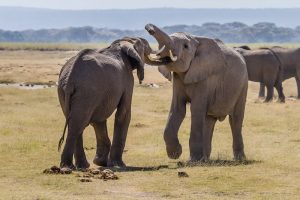UK’s Ivory Act 2018 finally in force
Posted on: June 16, 2022 by Emily Gould

via Wikimedia Commons CC-SA 2.0 by Benh LIEU SONG
It’s probably fair to say that not all of our predictions for 2022 in our traditional inaugural blog post of the year have yet come to fruition – or indeed, will do so before the year is out. On one topic, however, we called it right: that this year would finally see the UK’s Ivory Act of 2018 coming into force, implementing one of the toughest bans on the trade in elephant ivory in the world. A fairly safe bet, you might think, given the enactment of this new legislation over three and a half years ago. The subsequent chain of events, however, involving an action seeking Judicial Review which reached the Supreme Court, plus no less than three government consultations have rendered the progress towards enforcement a rather drawn out affair.
The announcement by the Government that the Act was finally coming into force was therefore met with relief in many quarters. The law took effect from 6th June, a day described by the UK Director for the International Fund for Animal Welfare as “a good day for elephants”. As discussed in previous blog posts, the Act imposes a near-total ban on trade in elephant ivory (covering both internal trade and imports and exports), subject to five relatively narrow exemptions. These are described in some detail in the useful government guidance, first published in February 2022 and recently updated. They include, as ‘standard’ exemptions: pre-1947 items with less than 10% ivory content and pre-1975 musical instruments with less that 20% ivory; pre-1918 portrait miniatures with a surface area under a specified threshold; and items being bought or hired by qualifying museums (i.e. those which are members of ICOM or are accredited by Arts Council England or equivalent authorities in the devolved nations). The fifth category of exempt items (perhaps the most controversial, given they may be more difficult to pin down) applies to pre-1918 items of “outstandingly high artistic, cultural or historical value”. Any dealing in these latter items will require an exemption certificate before proceeding with the transaction. Similarly, any trading in items falling within the ‘standard’ exemptions requires pre-registration with APHA (the Animal and Plant Health Agency – the government department responsible for administering the system). A short grace period is provided for transactions commenced before 6th June, allowing them to be completed before 3rd July without needing to register or apply for an exemption certificate.
There were reports of a flurry of activity in the ivory market in the weeks before 6th June, with auction houses busy selling off ivory items in anticipation of the ban. According to one account, UK auction houses sold more than 2,700 ivory objects worth over £840,000 in total during the month leading up to the implementation date. Whilst not entirely surprising, the persistence of trade at this level, despite the passing of the Act over three years ago and the apparent shift in public attitudes, might be considered somewhat concerning. It perhaps suggests that the fears expressed by some that the ban does not go far enough are not unfounded. If there is still such appetite for ivory objects, will the UK’s ban simply result in trade moving elsewhere to countries with less stringent controls?
A joint statement by a number of wildlife NGOs, whilst broadly supportive of the new legislation, cautioned against complacency and urged the UK Government to “demonstrate leadership beyond its own domestic ivory ban to call on the international community to prioritise the conservation of elephants”. Japan was highlighted as an important market where ‘tough measures’ are warranted, and the EU was urged to be vigilant in ensuring the proper implementation of new ivory guidance across its Member States. Another concern raised by this report (and numerous others) is that the failure of the current regulation to control the trade in ivory products from other species, most notably hippos, walruses and whales, presents a major loophole. Indeed, the extension of the ban to these species was the subject of one of the government consultations mentioned above, so the matter is clearly under serious consideration.
There will undoubtedly be a period of adjustment as traders grapple with the various registrations and exemption certificates they will require and become accustomed to the new systems. It is to be hoped that the new practices will soon become second nature, however, thus bearing out the promise of the legislation to put the UK “at the forefront of global conservation efforts” in this regard.
